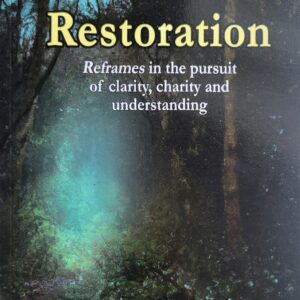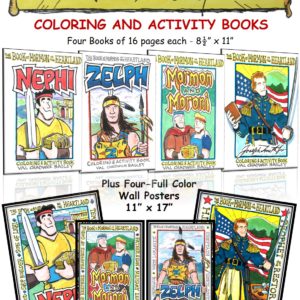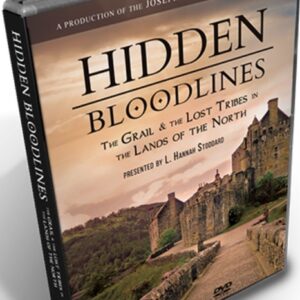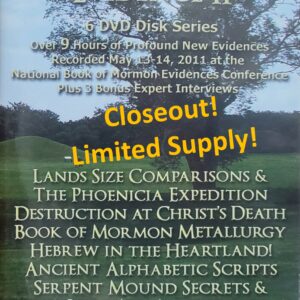Description
New 2nd-Edition 1st Printing. We just finished printing our newest version of the Annotated Book of Mormon. We have added additional references, pictures and some information. All new 2nd printing books contain 6 books per case not 8.
New Case Size 6 books per case (54.95 per book- Case price only)
$329.70 per case + sh
Combine the original text of the “most correct book on earth”, with the secondary evidences of archaeology, artifacts, geology and geography in the Heartland of the United States. The full case of 6 books will ship to one address for $329.70 ($54.95 each). Shipping is not included. Media Mail Shipping is about $28 which will arrive in about 5-10 days.
Edited by Edited by David R. Hocking & Rodney L. Meldrum. Nearly 600 pages of Prophetic Testimony, Evidences, Pictures, & Maps. Hardbound, Gold Embossed, 8½” X 11” and in Full Color!
For sample pages and more details, visit here.
THE Book of Mormon is an account of the “former inhabitants of this continent” that contains “the fulness of the everlasting gospel….as delivered by the Savior to the ancient inhabitants,” (Joseph Smith-History, 1:34) who were the “other sheep” Jesus spoke of during His ministry in Jerusalem.
The Annotated Book of Mormon has been created to help readers understand the everlasting gospel as explained in the text, together with what the modern prophets and apostles have taught about it. The text has been formatted so readers can identify natural conversations, poetic speech patterns, prophecies, and the words of God. The annotations include prophetic commentaries on quoted scripture and the use of colored text. (See “A Text Formatting Guide,” pp. xxv and xxvi). These elements bear witness to the divinity of this ancient text by drawing upon Hebrew tradition—much different from the nineteenth century rural America known to Joseph Smith.
The Annotated Book of Mormon also focuses on an important part of Moroni’s introduction; i.e., the “former inhabitants of this continent.” Joseph Smith, writing in Nauvoo, Illinois, in 1842, explained that “the remnant [of these ancient inhabitants] are the Indians that now inhabit this country.” (See Appendix, “Church History—Wentworth Letter,” pp. 546-549.) Oliver Cowdery mentioned this in his Letter VII (see p. 515).
There are “insight pages” inserted throughout the text. These include illustrations, images, maps and prophetic statements that support the proposition that the ancestors of the “Indians that now inhabit this country” closely fit the time frames and events described in the Book of Mormon. As such, their identity is an additional witness of the divine authenticity of the text. The “insight pages” are provided to enhance understanding of the text as an authentic history of the ancestors of the Indians who live in this country, not to establish a specific geography. It is recognized that, apart from the New York Cumorah, Church leaders have declined to correlate Book of Mormon sites with modern locations. It is left to individuals to do their own research and reach their own conclusions. In 1929, Anthony W. Ivins, counselor in the First Presidency, added, ‘There has never been anything yet set forth that definitely settles that question [of overall Book of Mormon geography]…We are just waiting until we discover the truth’ – Conference Report [April 1929], 16.
Regarding Cumorah, however, Church leaders have consistently taught the New York setting. President Cowdery’s Letter VII unambiguously declared that the New York hill was (i) the location of Moroni’s stone box from which Joseph obtained the plates; (ii) the scene of the final battles of the Nephites and Jaredites; and (iii) the site of Mormon’s depository of Nephite records (Mormon 6:6). Joseph Smith had Letter VII copied into his personal history as part of his life story. Letter VII was re-published in early Church publications including the Times and Seasons, the Gospel Reflector, the Millennial Star, the Prophet, and the Improvement Era. Prophets and apostles have reaffirmed this teaching, including Brigham Young, Wilford Woodruff, Heber C. Kimball, Joseph F. Smith, Joseph Fielding Smith, Anthony W. Ivins, James E. Talmage, LeGrand Richards, Marion G. Romney, and Mark E. Petersen.
Pursuant to the acquisition of the Hill Cumorah in Manchester, New York in 1928, President Anthony Ivins declared in General Conference, “It was here that two once-powerful nations were exterminated so far as their national existence was concerned. It was here that these nations gathered together for the last great struggles…all of the sacred records of the Nephite people, were deposited by Mormon in that hill.” (Improvement Era [June 1928]; see also “Celebration of the Purchase of the Hill Cumorah,” p. 440.
Beyond Cumorah, there have been a few other statements by Joseph Smith, Jr. and his contemporaries that readers may find interesting and useful. Incorporated in this Annotated Edition are maps that depict specific locations given through revelation, in journal entries, or in an official Church publication. These maps help explain how the Book of Mormon is a history of the ancestors of the Indians who live in this country, but they are not to be considered official Church doctrine.
—————————–FOOTNOTE——————————————————-*Letter IV is the one of eight letters written by Oliver Cowdery under the direction of Joseph Smith, Jr. The letters were written in response to the first anti-Mormon publication “Mormonism Unvailed” in the fall of 1834, which claimed that the Book of Mormon was fiction, plagiarized from other then-extant publications. These eight letters are significant to Latter-day Saints because parts of them have been canonized in the Pearl of Greet Price, other parts are quoted widely in historical research and excerpted into many Church publications and Conference talks. All eight letters were republished on multiple occasions and distributed widely during the first 100 years of the Church’s development. Letter VII is particularly significant because it provides the greatest amount of detail regarding the Hill Cumorah (see Mormon 6:2-6; pp. 438-439) that has ever been documented by the First Presidency in this dispensation. For more about these important letters turn to pp. 491, 512-16 and 522.






Reviews
There are no reviews yet.